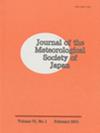An Atmospheric General Circulation Model Assessment of Oceanic Impacts on Extreme Climatic Events over Japan in July 2018
IF 1.6
4区 地球科学
Q3 METEOROLOGY & ATMOSPHERIC SCIENCES
引用次数: 4
Abstract
Through a set of ensemble experiments with an atmospheric general circulation model (AGCM), potential influence of sea-surface temperature (SST) anomalies is assessed on large-scale atmospheric circulation anomalies that induced two extreme events observed over Japan in July 2018. One is a heavy rainfall event in early July mainly over western Japan, which was primarily caused by extreme moisture inflow associated with a cyclonic anomaly to the southwest of Japan and an anticyclonic anomaly to the east of Japan. An AGCM experiment with prescribed global SST anomalies cannot reproduce the anticyclonic anomaly, leading to the failure to simulate the enhancement of the moisture inflow and thereby precipitation over western Japan. The other extreme event is heat wave in midand late July almost over the entire Japan, which was caused by a strong anticyclonic anomaly around Japan. The AGCM experiment with global SST anomalies can well reproduce the warm anticyclonic anomalies. The additional experiments have confirmed that SST anomalies in both the tropics and midlatitude North Pacific have potential for forcing the leading mode of the atmospheric variability over the western North Pacific that brought the heat wave. Both the tropical and extratropical SST anomalies are also found to force a poleward shift of the subtropical jet axis over the western Pacific and anomalous tropospheric warming in the midlatitude Northern Hemisphere, both of which persisted in June and July.2018年7月海洋对日本极端气候事件影响的大气环流模式评估
通过一组大气环流模式(AGCM)的集合试验,评估了海温(SST)异常对大尺度大气环流异常诱发2018年7月日本两次极端事件的潜在影响。一个是7月初主要在日本西部发生的强降雨事件,这主要是由日本西南部的气旋异常和日本东部的反气旋异常相关的极端水汽流入引起的。基于全球海温异常的AGCM实验无法再现反气旋异常,导致无法模拟日本西部水汽流入增强从而导致降水的增强。另一个极端事件是7月中下旬几乎覆盖整个日本的热浪,这是由日本周围强烈的反气旋异常引起的。全球海温异常的AGCM实验可以很好地再现暖反气旋异常。另外的实验证实,热带和中纬度北太平洋的海温异常都有可能迫使北太平洋西部大气变率的主导模态产生热浪。热带和温带海温异常也导致西太平洋副热带急流轴向极地移动和北半球中纬度对流层异常变暖,这两个异常在6月和7月持续存在。
本文章由计算机程序翻译,如有差异,请以英文原文为准。
求助全文
约1分钟内获得全文
求助全文
来源期刊
CiteScore
6.70
自引率
16.10%
发文量
56
审稿时长
3 months
期刊介绍:
JMSJ publishes Articles and Notes and Correspondence that report novel scientific discoveries or technical developments that advance understanding in meteorology and related sciences. The journal’s broad scope includes meteorological observations, modeling, data assimilation, analyses, global and regional climate research, satellite remote sensing, chemistry and transport, and dynamic meteorology including geophysical fluid dynamics. In particular, JMSJ welcomes papers related to Asian monsoons, climate and mesoscale models, and numerical weather forecasts. Insightful and well-structured original Review Articles that describe the advances and challenges in meteorology and related sciences are also welcome.

 求助内容:
求助内容: 应助结果提醒方式:
应助结果提醒方式:


